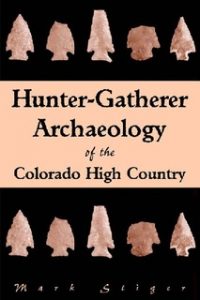Much has been written about the Native Americans in Colorado in the nineteenth century, particularly in relation to the whites who were migrating to their land. But what do we know about the Cheyenne, Arapaho, Ute, and other tribes’ early ancestors? Long before whites had explored and settled in what we now call Colorado, Paleo-Indians called this land home — and archaeological study is yielding clues about these ancient peoples.
Common wisdom says that Native Americans descend from Asians who crossed the land bridge to what is now Alaska about 15,000 years ago, although this is still under speculation. However they got here, it is estimated that people may have called Colorado home for as much as 11,000 years. Evidence of these prehistoric peoples include projectile points (spear/arrowheads); ancient bison and mammoth bones that show signs of having been hunted; remains of dwelling sites; and the 1963 discovery north of Fort Collins of the bones of a woman thought to have died 9,000 years ago. While many Coloradans today think of the cliff dwellers of Mesa Verde as the “ancient ones,” they are, in fact, relatively recent — having lived in Colorado only about 600 or 700 years ago.
Our library has numerous resources on archaeology and ancient Coloradans, including several great books from the University Press of Colorado (archaeology is one of their specialties):

- Archaeological Landscapes on the High Plains
- Frontiers in Paleoindian Archaeology: From the Dent Site to the Rocky Mountains
- Hunter-Gatherer Archaeology of the Colorado High Country
- Ice Age Hunters of the Rockies
- Late Paleoindian Occupation of the Southern Rocky Mountains: Early Holocene Projectile Points and Land Use in the High Country
- Prehistory in Peril: The Worst and Best of Durango Archaeology
- In the Shadow of the Rocks: Archaeology of the Chimney Rock District in Southern Colorado
The Colorado Historical Society (now History Colorado) includes an Office of Archaeology and Historic Preservation, which houses the State Archaeologist and oversees Colorado archaeological sites in cooperation with the Federal Government, which owns much of the land containing archaeological resources. Some of their publications include:
- Archaic Period Architectural Sites in Colorado
- Colorado Mountains Prehistoric Context
- Colorado Plains Prehistoric Context
- Northwest Colorado Prehistoric Context
- Prehistoric Paleo-Indian Cultures of the Colorado Plains
- Southwest Colorado Prehistoric Context
- West Central Colorado Prehistoric Context
Other resources in our library collection that tell the story of ancient Coloradans include resources from the Colorado Department of Transportation’s archaeology unit, which detail specific investigations. To find these and other resources visit our library’s online catalog.
- How to Spot the Differences Between Eagles and Hawks - August 16, 2021
- How Transportation Projects Help Tell the Story of Colorado’s Past - August 9, 2021
- Time Machine Tuesday: The Night the Castlewood Canyon Dam Gave Way - August 3, 2021